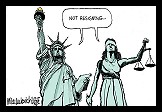Guest Blogged by John Gideon of VotersUnite.org
 According to a new report issued by VoterAction and Demos, “Direct Recording Electronic (DRE) voting machines, once considered essential to ensuring private and independent voting booth access for voters with disabilities, often do not work as promised, according to a new report published today. Authored by access technology expert Noel Runyan and published by election reform groups Demos and Voter Action, 'Improving Access to Voting: A Report on the Technology for Accessible Voting Systems' shows that, due to inadequate or malfunctioning voting machines, voters with disabilities are frequently forced to ask for assistance or compromise the privacy of their vote— severe violations of federal disability accommodation requirements. The report details significant difficulties for voters with disabilities, including: the lack of a controllable interface for those who are unable to use touch screens or tactile key inputs; inadequate audio access features for people with visual or cognitive impairments, with dyslexia, or with severe motor-impairments; and lack of privacy curtains to prevent others from reading the voters’ selections on their visual displays.
According to a new report issued by VoterAction and Demos, “Direct Recording Electronic (DRE) voting machines, once considered essential to ensuring private and independent voting booth access for voters with disabilities, often do not work as promised, according to a new report published today. Authored by access technology expert Noel Runyan and published by election reform groups Demos and Voter Action, 'Improving Access to Voting: A Report on the Technology for Accessible Voting Systems' shows that, due to inadequate or malfunctioning voting machines, voters with disabilities are frequently forced to ask for assistance or compromise the privacy of their vote— severe violations of federal disability accommodation requirements. The report details significant difficulties for voters with disabilities, including: the lack of a controllable interface for those who are unable to use touch screens or tactile key inputs; inadequate audio access features for people with visual or cognitive impairments, with dyslexia, or with severe motor-impairments; and lack of privacy curtains to prevent others from reading the voters’ selections on their visual displays.
'I originally had high hopes for the new voting machines' said Noel Runyan, the author of the report. Runyan, who is blind, is a professional electrical engineer who has spent much of his career developing access technologies for people with visual impairments. 'Even with my technical background and the help of poll workers, I could not get the Sequoia Edge II DRE to work. I have since tested most of the available voting systems at conferences and at the National Federation of the Blind’s accessible voting systems lab, and my fears have been confirmed: Most of the DREs deployed were not designed with real disability access in mind.'”...
--- Click here for REST OF STORY!... ---
 While organizations like People For The American Way, Common Cause, and Miami-Dade Election Reform Coalition argue that the continued use of DRE voting machines is necessary to support the foreign language speaking minority, they ignore that those machines may, in fact, serve to disenfranchise more voters from that community than they help. A new study from VotersUnite.Org proves that the undervote rate in minority communities in New Mexico plummeted when those communities changed from DRE to optical scan voting systems.
While organizations like People For The American Way, Common Cause, and Miami-Dade Election Reform Coalition argue that the continued use of DRE voting machines is necessary to support the foreign language speaking minority, they ignore that those machines may, in fact, serve to disenfranchise more voters from that community than they help. A new study from VotersUnite.Org proves that the undervote rate in minority communities in New Mexico plummeted when those communities changed from DRE to optical scan voting systems.

 Sunday 'Happyish Holidays' Toons
Sunday 'Happyish Holidays' Toons Trump Gets Trumped in Our Musky Year-End Roundtable: 'BradCast' 12/19/24
Trump Gets Trumped in Our Musky Year-End Roundtable: 'BradCast' 12/19/24 'Green News Report' 12/17/24
'Green News Report' 12/17/24
 About Some of Trump's 'Day One' Threats: 'BradCast' 12/18/24
About Some of Trump's 'Day One' Threats: 'BradCast' 12/18/24 Trump Family Corruption Cometh...So Does Our Opposition: 'BradCast' 12/17/24
Trump Family Corruption Cometh...So Does Our Opposition: 'BradCast' 12/17/24 'Green News Report' 12/17/24
'Green News Report' 12/17/24 Mistallied Contests Found in OH County, as Oligarchy Rises in D.C.: 'BradCast' 12/16
Mistallied Contests Found in OH County, as Oligarchy Rises in D.C.: 'BradCast' 12/16 Sunday 'Barrel Bottom' Toons
Sunday 'Barrel Bottom' Toons Trump Admits He Can't Lower Grocery Prices (Biden Just Did): 'BradCast' 12/12/24
Trump Admits He Can't Lower Grocery Prices (Biden Just Did): 'BradCast' 12/12/24 'Green News Report' 12/12/24
'Green News Report' 12/12/24 What 'Unprecedented and Powerful Mandate'?: 'BradCast' 12/11/24
What 'Unprecedented and Powerful Mandate'?: 'BradCast' 12/11/24 Trump Barely Won Natl'y, But Won 'News Deserts' By Landslide: 'BradCast' 12/10/24
Trump Barely Won Natl'y, But Won 'News Deserts' By Landslide: 'BradCast' 12/10/24 Bad Weekend for Authoritarians; Also: Pardon or Not?: 'BradCast' 12/9/24
Bad Weekend for Authoritarians; Also: Pardon or Not?: 'BradCast' 12/9/24 Fox 'News' and GOP Get Their Hateful War on Trans Kids at SCOTUS: 'BradCast' 12/5/24
Fox 'News' and GOP Get Their Hateful War on Trans Kids at SCOTUS: 'BradCast' 12/5/24 'Mind Boggles at Potential Corruption' in Trump Scheme: 'BradCast' 12/4/24
'Mind Boggles at Potential Corruption' in Trump Scheme: 'BradCast' 12/4/24 In Defense of Democracy from S. Korea to N. Carolina: 'BradCast' 12/3/24
In Defense of Democracy from S. Korea to N. Carolina: 'BradCast' 12/3/24 Hunter's Pardon: 'BradCast' 12/2/24
Hunter's Pardon: 'BradCast' 12/2/24 How (and Why!) to 'Extend Olive Branch' to MAGA Members: 'BradCast' 11/21/24
How (and Why!) to 'Extend Olive Branch' to MAGA Members: 'BradCast' 11/21/24
 VA GOP VOTER REG FRAUDSTER OFF HOOK
VA GOP VOTER REG FRAUDSTER OFF HOOK Criminal GOP Voter Registration Fraud Probe Expanding in VA
Criminal GOP Voter Registration Fraud Probe Expanding in VA DOJ PROBE SOUGHT AFTER VA ARREST
DOJ PROBE SOUGHT AFTER VA ARREST Arrest in VA: GOP Voter Reg Scandal Widens
Arrest in VA: GOP Voter Reg Scandal Widens ALL TOGETHER: ROVE, SPROUL, KOCHS, RNC
ALL TOGETHER: ROVE, SPROUL, KOCHS, RNC LATimes: RNC's 'Fired' Sproul Working for Repubs in 'as Many as 30 States'
LATimes: RNC's 'Fired' Sproul Working for Repubs in 'as Many as 30 States' 'Fired' Sproul Group 'Cloned', Still Working for Republicans in At Least 10 States
'Fired' Sproul Group 'Cloned', Still Working for Republicans in At Least 10 States FINALLY: FOX ON GOP REG FRAUD SCANDAL
FINALLY: FOX ON GOP REG FRAUD SCANDAL COLORADO FOLLOWS FLORIDA WITH GOP CRIMINAL INVESTIGATION
COLORADO FOLLOWS FLORIDA WITH GOP CRIMINAL INVESTIGATION CRIMINAL PROBE LAUNCHED INTO GOP VOTER REGISTRATION FRAUD SCANDAL IN FL
CRIMINAL PROBE LAUNCHED INTO GOP VOTER REGISTRATION FRAUD SCANDAL IN FL Brad Breaks PA Photo ID & GOP Registration Fraud Scandal News on Hartmann TV
Brad Breaks PA Photo ID & GOP Registration Fraud Scandal News on Hartmann TV  CAUGHT ON TAPE: COORDINATED NATIONWIDE GOP VOTER REG SCAM
CAUGHT ON TAPE: COORDINATED NATIONWIDE GOP VOTER REG SCAM CRIMINAL ELECTION FRAUD COMPLAINT FILED AGAINST GOP 'FRAUD' FIRM
CRIMINAL ELECTION FRAUD COMPLAINT FILED AGAINST GOP 'FRAUD' FIRM RICK SCOTT GETS ROLLED IN GOP REGISTRATION FRAUD SCANDAL
RICK SCOTT GETS ROLLED IN GOP REGISTRATION FRAUD SCANDAL VIDEO: Brad Breaks GOP Reg Fraud Scandal on Hartmann TV
VIDEO: Brad Breaks GOP Reg Fraud Scandal on Hartmann TV RNC FIRES NATIONAL VOTER REGISTRATION FIRM FOR FRAUD
RNC FIRES NATIONAL VOTER REGISTRATION FIRM FOR FRAUD EXCLUSIVE: Intvw w/ FL Official Who First Discovered GOP Reg Fraud
EXCLUSIVE: Intvw w/ FL Official Who First Discovered GOP Reg Fraud GOP REGISTRATION FRAUD FOUND IN FL
GOP REGISTRATION FRAUD FOUND IN FL

































